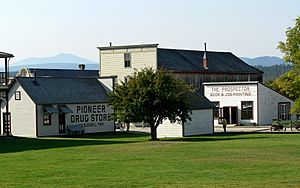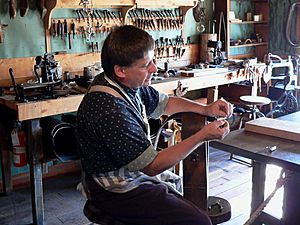Fort Steele, British Columbia facts for kids
Quick facts for kids Fort Steele, British Columbia |
|
|---|---|

Commercial buildings, Fort Steele, 2006
|
|
| Location | East Kootenay, British Columbia, Canada |
| Founded | 1864 |
| Governing body | Cranbrook Archives, Museum, and Landmark Society (non-profit), Heritage Branch, Province of British Columbia |
|
Invalid designation
|
|
Fort Steele is a special heritage site in the East Kootenay area of southeastern British Columbia. It's a popular place for visitors to learn about history. You can find it on the east side of the Kootenay River, between the St. Mary River and Wild Horse River. By road, it's about 17 kilometres (11 miles) northeast of Cranbrook.
Contents
Crossing the Kootenay River
Early Ferries and Bridges
Back in 1864, a man named John Galbraith came to look for gold. But he soon found a better way to make money. He started a ferry service across the Kootenay River. This ferry helped many gold miners get to the Fisherville mining camp.
John also opened a general store. Both his store and the ferry made good money from the gold rush traffic. His brother, Robert Galbraith, later took over the ferry. This ferry could carry animals, but not big wagons.
From Ferry to Modern Bridge
The ferry service continued for many years. In 1888, a lift bridge replaced the ferry. This bridge was destroyed by a flood in 1894. Over the years, several different bridges were built to cross the river. The most recent one, a concrete bridge, was built in 1966 when the highway was changed.
How Fort Steele Got Its Name
From Galbraith's Ferry to Fort Steele
At first, the area was known as Galbraith's Ferry because of John Galbraith's ferry. In 1887, Superintendent Sam Steele arrived with a group of police officers. They were from the NWMP, which was like Canada's early police force.
They came to help calm things down between settlers and local First Nations people. The police built a compound that looked like a fort, even though it wasn't a real military fort. Sadly, some officers died from typhoid fever. In 1888, the community decided to change its name to Fort Steele, honoring Superintendent Steele.
Getting Around and Supplies
Old Roads and River Travel
In the early days, supplies for Fort Steele came by pack train from places like Walla Walla, Washington. A wagon road heading north to Canal Flats opened in 1886.
During summer, people could travel between Golden and Fort Steele using riverboats, small trains, and stagecoaches. Later, a wagon road to the Elk River was finished in 1895. This road connected Fort Steele with Montana in the United States.
Modern Roads
By the late 1890s, riverboats also carried passengers and goods between Jennings, Montana, and Fort Steele. The main highway that ran through Fort Steele was moved to its current location in 1965.
Life in the Old Town
Boom and Bust of a Mining Town
In 1864, Fort Steele had over 3,000 people, mostly gold miners. But just five years later, most miners had left for other places. By 1888, the police had moved away, and only a few settlers remained.
In 1892, the town had government buildings, a hotel, and two stores. In 1894, the town was officially mapped out. Miss Adelaide Bailey became the first teacher, and two more hotels were built. Fort Steele was growing into an important mining center.
Growing Pains and Decline
By 1897, Fort Steele was booming! Many new hotels opened, and a large Government Building was built. It had jail cells, a courtroom, and offices. The town also got a hospital, an opera house, and a Roman Catholic church. New businesses opened, and the town connected to the US telegraph network. The population grew from about 300 to 3,000 people in just six months.
However, things changed quickly. In 1898, a water system was installed, and a volunteer fire department started. But when the railway decided to bypass Fort Steele, many people began to leave. Businesses started moving to nearby towns like Cranbrook and Fernie.
The Fire and Final Closures
In December 1906, a big fire destroyed most of the business area. The town couldn't afford to keep its water tank full for fire protection. Even after the fire, the town kept going for many years. The school closed in 1954, and the last general store closed in 1961. The post office, one of the last services, closed in 1997.
| Census population: Fort Steele |
||
|---|---|---|
| Year | Pop. | ±% |
| 1951 | 349 | — |
| 1956 | 105 | −69.9% |
| 1961 | 125 | +19.0% |
| 1966 | 56 | −55.2% |
| 1971 | 53 | −5.4% |
| 1976 | 40 | −24.5% |
| 1981 | — | |
| 1986 | 118 | — |
| 1991 | 99 | −16.1% |
| Source: Statistics Canada |
||
The Railway's Impact
Why the Train Skipped Fort Steele
The Canadian Pacific Railway (CP) was building a new line. Many people thought Fort Steele would be a major stop because it was a good location. However, a man named Colonel James Baker offered CP land in Cranbrook for free. He knew that a railway would help Cranbrook grow.
Robert Galbraith, who owned land in Fort Steele, didn't make a similar deal. So, in 1898, the railway tracks went through Wardner and then to Cranbrook, completely bypassing Fort Steele. This decision had a huge impact on Fort Steele's future.
Later Railway Connections
Later, another railway, the Kootenay Central Railway (KCR), a CP company, did build tracks near Fort Steele. Train service through the area began in January 1915.
In the 1970s, a new dam created Lake Koocanusa. This meant the old railway bridge at Wardner had to be removed. A new rail bridge was built at Fort Steele in 1970, and the tracks were rerouted across it.
Fort Steele Today: A Heritage Town
What is Fort Steele Heritage Town?
Because it was the first NWMP post in British Columbia, Fort Steele was named a National Historic Site of Canada in 1925. In 1961, the province bought the site to turn it into a historic park.
In 2004, a non-profit group called the Friends of Fort Steele Society took over managing the site. They worked on many projects, including a new visitor center and fixing up the steam train. As of April 1, 2025, the Cranbrook Archives, Museum and Landmark Society (CAMAL) began managing the site.
What Can You See and Do?
Fort Steele Heritage Town is like stepping back in time! You can see real buildings from the old town, like the schoolhouse, two churches, the Opera House, and the Windsor Hotel. Some buildings were moved to the site, and others are careful copies.
Actors dressed in old-fashioned clothes walk around the town, making it feel very real. You can watch live shows at the Wildhorse Theatre. Visitors can also try gold panning, take rides in horse-drawn wagons, and watch demonstrations like blacksmithing. You can even get your picture taken in an old-time style!
Steam Train Rides
During the summer, you can take a fun steam train ride. It's a 2.5-mile (4-kilometer) round trip, with a short stop at the "St. Mary's look-out" for great views.
The fort has two main steam locomotives:
- A Shay locomotive called "115" was built for logging. It's special because it was made from parts of two damaged trains. It's currently the largest Shay locomotive in Canada, but it's not running right now due to engine problems.
- A 2-6-2 prairie class locomotive called "1077" was built in 1923. It's the main train used at the fort today. The 1077 was one of the last steam trains used in Canada before it was retired in 1969. It has even been in movies like The Grey Fox and The Journey of Natty Gann.
See Also
- Barkerville, British Columbia, another historic town you can visit.
- List of heritage railways in Canada
- List of museums in Canada


